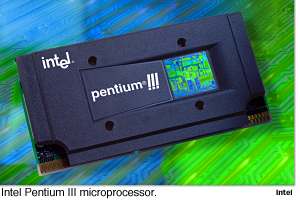

|
|
|
A 1,000MHz PIII? 
Intel shows a Pentium III running at more than 1,000MHz. Who says it has a performance problem? PALM SPRINGS, Calif. -- Despite an announcement of a Pentium III running at 1,002MHz on Tuesday, customers will still have to wait until late in the year 2000 -- or even 2001 -- before they see such speeds on the desktop, said execs at Intel Corp. "This is not something you are going to be able to buy," said Pat Gelsinger, vice president and general manager of Intel's desktop products group, during a keynote here at the Intel Developers Forum. The comments came after Intel (Nasdaq:INTC) showed off a Pentium III processor running at 1,002MHz -- about 1GHz -- essentially twice as fast as the current rated speed for the chip. New speeds, old tricks Intel officials would not release details of the cooling mechanism used to allow the processor to be overclocked, but one spokesperson believed liquid nitrogen was used. Intel has no intention of using the cooling system in any products -- liquid nitrogen is not something that lies around the house. Today's fastest desktop processors run at 450MHz -- less than half of the super-cooled 1GHz processor. It will take almost two years for standard processors from Intel to reach that high clock speed with out special cooling technology, said Albert Yu, senior vice president and general manager of Intel's microprocessor group, during his keynote. Jousting with AMD Last year, AMD (NYSE:AMD) claimed that it would have a consumer-ready processor running at 1GHz by the year 2000 -- at least six months before Intel's plans for similar speeds. So Intel's demo Tuesday at least put the company in the same territory. Intel's roadmap for its processors puts the maximum speed of desktops at 600MHz for 1999 -- but the speed race is somewhat of a moot point, however. While the market focuses on clock speeds as a measure of speed, many other factors go into determining processor performance. Cools the rule AMD's just-announced processor -- the K6-3 -- is expected to outperform the Pentium II, even though it will most likely run at lower clock speeds, said Peter Glaskowsky, analyst with MicroDesign Resources Inc., during a recent interview. That chip was announced by AMD on Monday. |
Send mail to aztechetic@yahoo.com with questions or comments
about this web site.
|